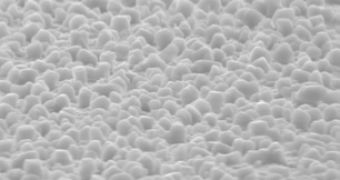Micro-electro-mechanical systems, popularly referred to as MEMS, in small electronic devices often fail because of adhesion and stiction - the attractive force between the surfaces of interacting parts.
University of Arkansas researchers have developed a surface-topography engineering method that reduces these forces and will help microscopic parts interact and function smoothly.
"There are two approaches to address adhesion and stiction issues in MEMS devices" said Min Zou, assistant professor of mechanical engineering at the U.A.
"One is chemistry- applying chemicals to weaken the forces.
The other is topography engineering.
Our approach was simple - we engineered nanoscale bumps to reduce the contact area between surfaces."
The goal of the surface was to create a hydrophobic surface, that is a surface that reduces the friction with water to a minimum, so that the water will not adhere to the surface and interact with its molecules, but it will "bead up" or turn into a ball.
An example of such a surface is a chemically treated windshield to which the raindrops never stick, being pushed away by wind, gravity and centrifugal force.
The water-contact angle is the measurement used to describe the extent to which water beads. The greater the angle, the less powerful the friction forces.
A water-contact angle greater than 90 degrees is considered hydrophobic, and any angle greater than 150 degrees is considered superhydrophobic.
With a water-contact angle of approximately 180 degrees, beads represent a near-perfect sphere with only minimal contact on surfaces.
Using only topography-engineering methods on amorphous silicon and aluminum induced crystallization that manifested as nano- or microcrystallites to form the textured surfaces, Zou's team achieved a water-contact angle as high as 137 degrees on silicon, the highest ever without the use of chemicals, and by combining the two methods, the researchers achieved an angle greater than 150 degrees, thus producing a superhydrophobic surface.
Less friction means less energy required for functioning, less lubricating fluids being used and so, less maintenance required for moving parts inside various devices, all these factors converging to achieve a higher lifespan and increased durability of the devices.
This could be extremely useful in mechanical moving parts like gears and bearings, in microelectronics areas like head-disk interfaces in computer hard drives, but mostly in extreme environments and remote areas, where human maintenance is costly and even dangerous, like polar regions, and even in outer space. It is also relevant for medical implants.

 14 DAY TRIAL //
14 DAY TRIAL //